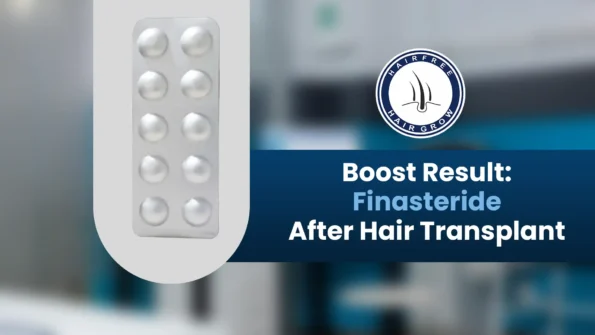Hair transplant surgery is an effective solution for people who have experienced hair loss in the past. However, it may not be the only step of the hair restoration process. Many patients suffer from pattern balding caused by genetics, and to prevent future hair loss, a hair transplant surgeon may suggest ongoing preventative treatments, such as finasteride. Learn how Finasteride after hair transplant can help improve hair growth and maintain results.
Finasteride is a popular drug that is prescribed worldwide for hair loss, and it is one of the most successful non-surgical treatments for male hair loss. In this article, we will discuss finasteride, whether it should be used after a transplant, the benefits of finasteride, and alternative treatments available.
What is Finasteride?
Finasteride is a medicine approved by the FDA for treating hair loss. It can be taken orally or applied topically. The medication reduces the production of DHT, a hormone that causes hair follicles to shrink and eventually stop producing hair. Finasteride comes in 1mg and 5mg strengths, with the 1mg strength sold as Propecia for hair loss, and the 5mg strength marketed as Proscar for treating benign prostate enlargement.
Studies have shown that finasteride is effective at stopping and reversing hair loss of the scalp, but it does not affect hair growth on the body. For those looking to improve their beard growth, minoxidil is a more effective option. Finasteride is not recommended for women, unlike minoxidil.
Finasteride After Hair Transplant: Do I Have to Take It?
Whether you need to take finasteride after a hair transplant largely depends on your individual situation. While it’s not a mandatory requirement for the success of the transplant itself, many doctors suggest considering finasteride, especially if you’re dealing with androgenetic alopecia (male or female pattern baldness). Here’s why:
- Controlling Future Hair Loss: Finasteride can help in preventing further hair loss beyond the transplanted area. It targets the root cause of androgenetic alopecia by blocking the hormone responsible for shrinking hair follicles.
- Accelerating Hair Regrowth: By taking finasteride, you might experience quicker hair regrowth in both the transplanted and existing hair areas. This can lead to more satisfactory results in a shorter time frame.
- Reducing Post-operative Shedding: After a hair transplant, it’s common for some of the transplanted hairs to temporarily shed before regrowing. Finasteride may help minimize this shedding phase, ensuring better retention of the transplanted grafts.
Ultimately, whether or not to use finasteride post-transplant should be discussed with your surgeon, taking into account your specific hair loss pattern, medical history, and any potential side effects of the medication.
How Long Do You Have to Take Finasteride After a Hair Transplant?
After getting a hair transplant, it’s important to understand that continued use of finasteride may be necessary to maintain your new hair growth. If you stop taking finasteride, your hair loss can resume quickly because the production of DHT, a hormone linked to hair loss, restarts.
For the best results in maintaining hair density post-transplant, it’s recommended to use finasteride on a long-term basis, possibly indefinitely. Studies have shown that consistent daily use over time yields better outcomes. Research indicates that within one year, about 48% of patients experienced clear hair growth, increasing to 66% after two years. In a study following 2,561 men over five years, an impressive 87.1% of patients noted hair regrowth during that period.
So, for those considering or who have just undergone a hair transplant, incorporating finasteride into your daily routine can significantly help in preserving and promoting hair growth over the long term.
Does Finasteride Have Side Effects?
When considering finasteride for hair transplant patients or those who have recently undergone the procedure, it’s important to be aware of potential side effects, including:
- Poor mood
- Sexual dysfunction, which is uncommon but can occur in around 2.1-3.8% of users
If you are hesitant about taking finasteride due to these side effects, it’s advisable to discuss alternative options with your surgeon. They can assess the viability of additional hair transplants in the future based on the hair quantity present at the back of your head. Having ample hair in this area may enable you to undergo further hair transplant procedures if needed.
Written By
MBBS, DDV
Dr. Jinkal Kunjadiya is a skilled hair transplant specialist with extensive knowledge in the use of Finasteride after hair transplant procedures. He helps patients achieve long-term results and enhanced hair growth through effective post-transplant care.
Disclaimer
We’ve made all possible efforts to ensure that the information provided here is accurate, up-to-date and complete, however, it should not be treated as a substitute for professional medical advice, diagnosis or treatment. See Detailed Disclaimers Here.



